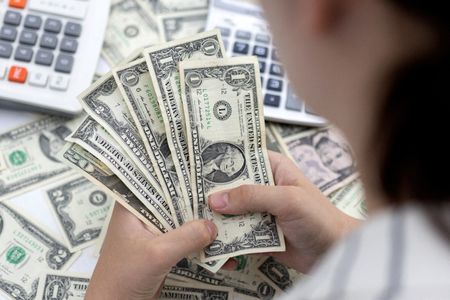
By Kevin Buckland
TOKYO (Reuters) – The U.S. dollar slipped from near a one-week peak versus major peers on Wednesday, with traders on tenterhooks before a looming Federal Reserve rate decision that should also give clues on the future policy path.
The yen outperformed, seeing a sudden burst of strength mid-morning Japan time, with traders on alert for possible intervention around the Fed meeting.
The dollar index – which gauges the greenback against a basket of six counterparts that includes the yen, euro and sterling – eased 0.14% to 111.33, but still not far below Tuesday’s high of 111.78, which was the strongest level since Oct. 25.
The index rode a yo-yo overnight, dropping fast in the European open only to recover those losses after U.S. data pointed to continued price pressures, dampening speculation of a Fed pivot this year. U.S. job openings unexpectedly rose, suggesting wage growth remains elevated, while construction spending staged a surprise rebound.
Investors widely expect the Fed to raise its benchmark interest rate by 75 basis points (bps) on Wednesday, the fourth such increase in a row. But for the December meeting, the futures market is split on the odds of a 75- or 50-bps increase amid recent suggestions from Fed officials of a potential slowdown in the tightening pace.
“In the Fed’s view, putting the U.S. into a recession is still a lesser evil than not tackling entrenched price pressures,” Chris Weston, head of research at Pepperstone, wrote in a client note.
“It seems highly unlikely that the Fed will want to promote a positive reaction in risky assets, and the risks to markets in my mind are skewed to a hawkish reaction – equity up, bond yields and the USD lower.”
The dollar index has surged more than 15% this year as the Fed has hiked rates hard, crushing other currencies and heaping pressure on the global economy.
The yen has been particularly vulnerable to dollar strength, spurring the Ministry of Finance and Bank of Japan to intervene to support the currency in September for the first time since 1998. Japanese authorities are widely considered to have waded in several times again in October to pull the yen back from 32-year lows just shy of 152 per dollar, although they declined to confirm any action.
On Wednesday, the Japanese currency jumped suddenly by about half a yen to 147.4 per dollar. It then extended those gains, with the dollar last down 0.55% at 147.40 yen.
“This doesn’t look like intervention to me,” said Ray Attrill, head of FX strategy at National Australia Bank.
“On the three occasions that we know about, the BOJ intervened in enormous size and repeatedly, and if we were seeing intervention now – unless the pattern has changed – I would expect we would see much more significant movements that would be continuing now.”
The euro edged up 0.15% to $0.9888, but still close to the previous session’s one-week low at $0.98535.
Sterling rose 0.17% to $1.1505, but remained not far from Tuesday’s one-week low of $1.14365.
The Bank of England announces its policy decision on Thursday, and markets expect a 75-bps increase there as well, followed by a slowdown to a 50-bps pace in December.
The Australian dollar was little changed at $0.63945, consolidating near a one-week low. The Reserve Bank of Australia opted to keep its pace of rate hikes at 25bps on Tuesday, despite consumer inflation running at a 32-year high.
The kiwi dollar rose 0.16% to $0.58485, garnering support after an upbeat jobs report reinforced the case for a super-sized increase in interest rates this month from the Reserve Bank of New Zealand.
(Reporting by Kevin Buckland. Editing by Gerry Doyle)

